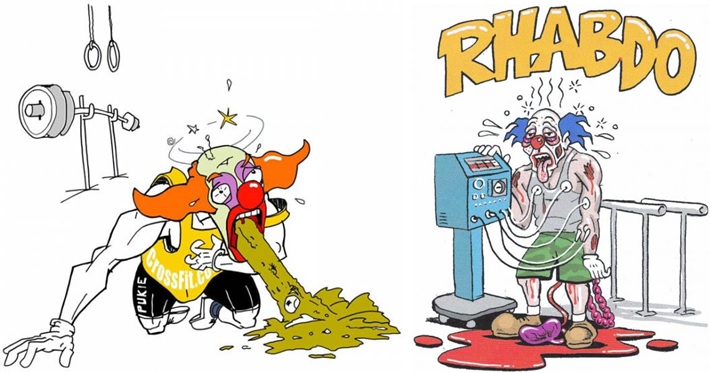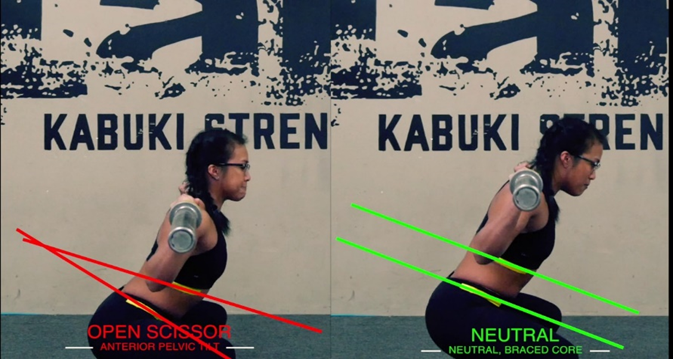Gains Without Pain
by Erik Castiglione
“There are no gains without pains” – Poor Richard (pseudonym of Benjamin Franklin)
“What does not kill me makes me stronger” – Friedrich Nietzsche
“Pain is weakness leaving the body” – USMC
“Pain don’t hurt” – Dalton (Patrick Swayze’s character in Roadhouse)
The first two quotes above were general observations about society and life in general – self-improvement, whether spiritual, financial, etc. requires hard work, blood, sweat, and tears. These ideas have since been taken and applied to the world of physical fitness, generating the latter two quotes. They have led to the idea that unless you’re in pain during/after a workout, you’re not hardcore and you’re just wasting your time.
The early days of CrossFit were full of images that embraced this ethos – many gyms had two buckets side by side, one for chalk, and one for puke. “Pukie the Clown” was the mascot of CrossFit, along with his “Uncle Rhabdo.” Torn hands were shown off as badges of honor (I still have some early photos of mine). CrossFitters would even brag about having trouble walking downstairs or sitting down to a toilet. At some point, pain and soreness became conflated with training results. In fact, pain and soreness are so common that many of us have forgotten what it’s like to feel GOOD. Training is supposed to improve the quality of our lives rather than detract from it, and pain IS a problem. To understand it, we must first distinguish between discomfort, soreness, and pain.
Discomfort is normal during workouts, particularly those that are higher intensity. When we push ourselves to grow, it’s uncomfortable. We may experience elevated heart rates, labored breathing, and burning muscles. I’ve written previously about forcing our bodies to adapt by disrupting our equilibria, and this is the only way to drive growth. Sometimes when we push hard, or do more reps than we’re used to, we MAY have some soreness. From time to time, this is okay. BUT it should never be the goal of a workout.
In fact, soreness can be counterproductive to long-term progress. If you’re too sore to work out, you’ll likely skip a day of training. The best results come from consistency rather than intensity; being forced to sit out because of soreness doesn’t help. Instead, focus on the goal of each training session, and scale appropriately. You can build mental toughness by pushing through discomfort, without wrecking yourself (unless the goal of the day is to leave you gasping for air making sweat angels on the floor).
Pain is a signal to your brain that something is WRONG. Only you can tell the difference between pain and discomfort. When you’re in pain, it’s time to figure out what is wrong and fix it. Too often we try to suck it up and push through, and we end up making things worse. In instances of light aches and soreness, some mobility work and self-myofascial release (lax ball/foam rolling) can help. In more severe cases, we might need to enlist the help of a licensed massage therapist, chiropractor, physical therapist, or, if we ignore pain long enough or have a catastrophic injury, an orthopedist.
Catastrophic Injury:
Once we know what’s wrong and have a plan to fix it, we can train around it. And, while we train around injuries and issues, pain is our friend; if we do something that hurts, STOP. This is valuable feedback when we’re forced to fix our movement patterns. For example: I, like many of you, spend too much time sitting. This leads to short and stiff hip flexors, which pull us into anterior pelvic tilt, which in turn compresses our low back. Since this is “normal” posture for many of us, it’s the position in which we brace before bearing weight in a back squat or deadlift. Both these movements add stress to the low back, so by bearing additional weight in an already compromised position, we further endanger our spines and surrounding musculature.
Three years ago, I stood up from a light back squat and it felt like a zipper was forcefully coming undone up the length of my left spinal erector. I dumped the bar and couldn’t stand for 10 minutes. It took a week to be able to stand/sit/walk without pain, and getting back into training took longer. I had to start super light, and I was forced to focus on my posture, tuck my hips, and brace before moving. This turned out to be a blessing in disguise. As I fixed my posture and movement patterns, I actually exceeded my previous best lifts within 6 weeks of my injury. Had I not adjusted; I would have been sidelined for much longer. I use this example because I know of several of our members who have a similar problem, and several more who are on their way.
The bottom line: discomfort and occasional soreness are part of normal training. Bruised collarbones, torn hands, and scraped shins also happen on occasion. Muscle and joint pain, especially when chronic, is your body’s way of telling you that there’s a problem. Use this information, get your injury diagnosed, train around it, and let us help you correct your movements so that the problem doesn’t return. Pain and injury are not badges of honor; your long-term progress and living a pain free life are. Here’s to pain-free training and living.



